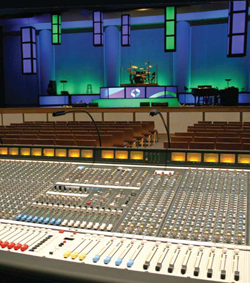
Get Organized
Another key to successfully managing monitors in a church setting is staying organized.
Work to develop a standard board layout that stays pretty consistent week to week.
Input channels should be labeled, as should the aux sends.
When responding to requests for monitor changes, nothing is more frustrating than adjusting the wrong send because they’re not labeled.
Typically, I like to set my console up in the more or less standard layout of kick, snare, hat, toms, overheads, bass, guitars, keys, vocals, effects, playback, and spoken-word microphones.
Feel free to expand or shrink sections as needed based on your actual input list.
Some engineers like to lay out their monitors from left to right (as viewed from front of house), meaning monitor 1 is on house left (stage right) and monitor 4 is on house right.
This works, though I prefer to have my worship leader on monitor 1 and build from there. Usually this means vocals are monitor 2, piano and guitars are monitor 3, drums and bass are monitor 4.
However you lay it out, however, find a method that works for your church, and stick to it as closely as possible week to week. Consistency makes life easier.
Sound Check
If I had to pick one place where most monitor mixes go wrong, it would be sound check, where the initial gain structure is set up. Getting a proper gain structure very early in the process is absolutely critical to good monitor (and house) mixes.
If you don’t get your input gain set up right at the beginning and you start changing it two or three songs into rehearsal, the level of that input will change in all your monitor mixes.
Changing one input often causes the band members to think other things are changing as well. Pretty soon, you’re back to working on monitor mixes.
Some people will differ with me on this, but I like to have the band in the house while I’m building monitor mixes.
I’ve done it both ways and find that because the band will hear at least some of the house sound – and that will effect their monitor mixes – we might as well deal with it from the get go.
Sound check should not be a free-for-all. It needs to be organized and led by one person, preferably the sound engineer, though some churches (inexplicably) like the worship leader to run it. Either way, it should proceed in a logical and consistent manner.
I like to work through the band one mic at a time, getting my gain set correctly with just that instrument playing. I start with drums, then bass, guitars, keys, and finally vocals. Others prefer working from the vocals back.
Try both methods and see which works better for you. Have musicians raise their hand if they want that mic in their mix, and when they have enough, they drop their hand.
